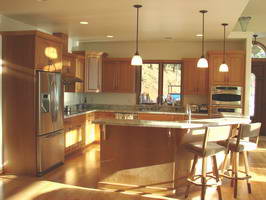Figuring Volts Watts and Electrical Amperage
 '; ';
|
How to Calculate Electrical Loads and Circuits using Ohms Law: The Most Common Electrical Calculation using Ohms Law © By: Dave Rongey |
Understanding and Calculating Electrical Circuit Loads
[ad#block]Electrical Question: I am trying to calculate an electric circuit for my kiln.
- I am making the kiln using Kanthal element wire coils.
- The coil itself is 16 ohms, making 3500 watts, and drawing about 14 amp’s. I wish to have another coil too.
- I know if I add this coil in a parallel connection with 1st coil, I will get more watts at same voltage but will my amperage rise?
- I think it won’t double as I think it would in a series connection and what do you think it would be?
- As I want my kiln to have over 6000 watts heating power but don’t know if the amps will rise too much if I set it up in parallel for my wall plug and I think that is about 20 amp’s or so.
- I get the feeling this will draw about 17 amp’s or so.
Background: David from Brisbane, Australia.
Additional Comments: Seems very helpful and a simple nice clean look.
Dave’s Reply:
Thanks for your electrical question David.
How to Calculate Electrical Loads and Circuits using Ohms Law
- David, this all sounds fine, however if you want to be extremely accurate then just use one of the ohm’s law formulas to find out what your electrical load will actually be.
The Most Common Electrical Calculation of Ohms Law
To find out the Amperage when the voltage and watts or resistance is known simply make this electrical calculation:
Watts / Volts = Amps
Example:
3500 watts / 240 volts = 14.6 amps
More about OHMS Law and Electrical Wiring
Ohms Law Formula
Using the Ohm’s Law is a way to determine information needed to understand how to design electrical circuits.
This formula works with three main variables and depending on what is known can produce a missing factor which is needed to determine the circuit size.
The Ohm’s Law is also used when designing appliances and building electrical equipment and devices.
Electrical Wire for the Home
Complete listing of electrical wire types and parts used for home projects with electrical code information serves as selection guidelines.
See Also:
Cord and Plug Safety for Electric Kilns
I was given an old, electric jewelry kiln. It draws 14 amps. No identification available. It fires up to about 1650 degrees F., but the plug would get too hot to touch. We replaced the old 2-plug Continue reading
The following may also be helpful for you:
|
|
Be Careful and Be Safe - Never Work on Energized Circuits!
Consult your Local Building Department about Permits and Inspections for all Electric Wiring Projects.
More articles about Electric, Kiln and Home Electrical Wiring: |
|
| « Previous | Next » |
How to Identify Cord Wires |
Electrical Circuit for a Tanning Bed |
















